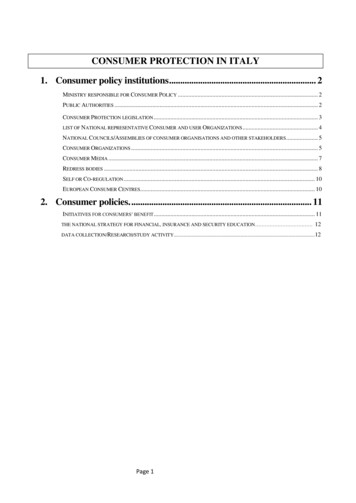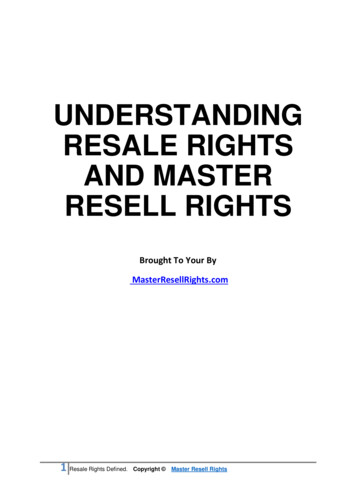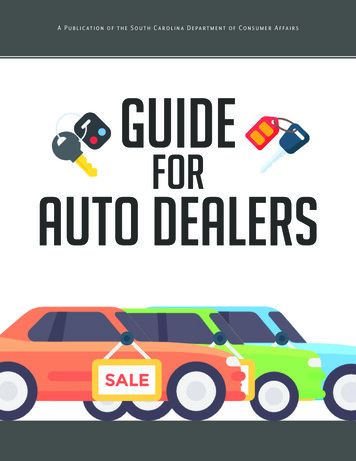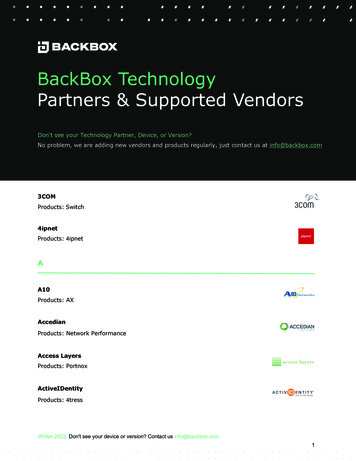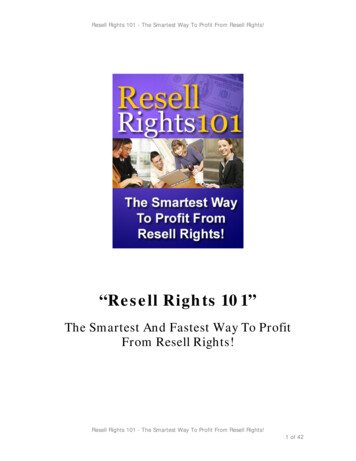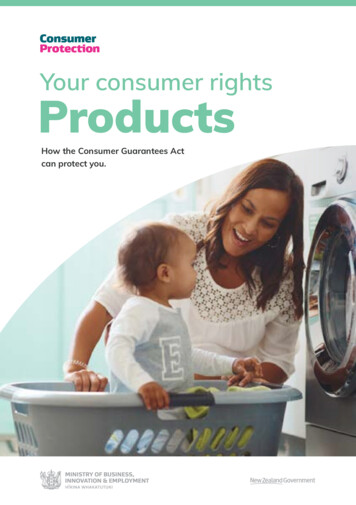
Transcription
Your consumer rightsProductsHow the Consumer Guarantees Actcan protect you.
How to use this bookletThis booklet helps you to solve product issues.It includes information on all parts of the process –from your rights, to how to make a complaint.Connect your issue to the Consumer Guarantees ActUse our flow chart to see which guarantee best fits your issue. –page 4Turn to the page given in the flow chart to learn more about yourguarantee.ContentsYour rights as a shopper. 3Refund, replacement, repair.18Where your issue fits inthe Consumer GuaranteesAct (CGA). 4If a fault causes extra losses .21Guarantees for products. 6Second-hand shopping.24When the CGA doesn't apply.13Buying on credit.25Warranties vs CGA.14How to resolve your issue.26Is it a minor or major issue?.16Complaint notes.28Buying online.23
Your rights as a shopper(consumer)When buying products in New Zealand, you have rights underdifferent laws. One of the main laws for shopping and buying isthe Consumer Guarantees Act (CGA).It does two things:1. Sets minimum standards(guarantees).2. Gives possible solutions ifsomething doesn’t meet thesestandards (remedies).The CGA covers products andservices. If your issue is with aservice provider, e.g. hairdresser,builder, plumber, lawyer or doctor,see our services booklet.These laws also protectconsumers:Fair Trading Act – businessesand sellers cannot mislead ordeceive you. Also covers productsafety and special rules for laybysor buying from uninvited sellers,e.g. telemarketer, truck shop.Credit Contracts and ConsumerFinance Act – lenders mustact responsibly when lendingyou money.Your consumer rights : ServicesYour consumer rightsServicesHow The Consumer Guarantees Actcan protect you.For more on the Fair Trading Act and the Credit Contractsand Consumer Finance Act, see Consumer Laws onconsumerprotection.govt.nz and our other booklets.Your rights as a shopper (consumer)3
Where your issue fits in theConsumer Guarantees Act (CGA)Your rights under theConsumer Guarantees Act:Your issue in detail – findone or more that apply:My issue:Start with the statements at the top of the chart. Pick one that best matchesyour issue. Follow the arrows to find the relevant CGA guarantee. You might becovered by more than one part of the Act.Product is not what I expected, or what Ithought I was buyingDelivery of the productNot as describedDoesn’t do what theseller said it wouldNever arrivedDifferent fromsample/floor modelDoesn’t do what I toldthe seller I needed it forTook too longto arriveMatch description, sampleor demonstration modelFit for particularpurposeArrive on time, ingood conditionProduct must match:Product must suitthe function:Deliveries must beeither:description incatalogue, online, onpackaging/labelsany sample ordemonstration modelshown by sellerSee page 74 Where your issue fits in the CGAyou told theseller aboutseller toldyou it wassuitable forSee page 8on timewithin areasonable timeframe if no time/date agreedSee page 9Arriveddamagedor broken
My problem isn’t onthe chartFor less common guarantees, see:Reasonable price – page 11Right to sell product – page 12Product doesn’t work –and it’s not my faultSpare parts and repair facilities –page 11The CGA doesn’t cover yourissue if you:Didn’t last longBreaks easilyDoesn’t do the job it’s made forUnsafeFlaws or faultsQuality doesn’t match what I paid for itAcceptable qualityProduct must be:fit for its normal purposeacceptable in appearancefree from flawssimply change your minddamage it yourself, e.g. droppingyour phonebuy privately, e.g. garage salemisuse or alter it, e.g. ignoreinstructionsknow about any faults or flawsbefore you buybuy commercial products for privateor household use, e.g. commercialmicrowave, industrial machinerybuy products to resellbuy products used up inmanufacturing, e.g. using cementto make concreteSee page 6rely on someone other thanthe sellers advice, and that causesthe problem.If your manufacturer’swarranty has expired, theacceptable quality guaranteemay still apply. See page 14are a business dealing with anotherbusiness, and you agree in writingto opt out.safe and durableWhere your issue fits in the CGA5
Guarantees for productsWhen you buy a product, it must meet guarantees setby the Consumer Guarantees Act (CGA). Follow the chart(see page 4) to see which guarantee(s) cover your issue.Here are detailed descriptions of each CGA guarantee.Acceptable qualityA product must be:fit for its normal purpose,e.g. a fridge keeps food coldacceptable in finish andappearance, e.g. a new phonewithout scratchesfree from defects or flaws,e.g. clothing with no broken zipsor missing buttonssafe, e.g. a phone chargershouldn’t spark when plugged indurable, e.g. last for a reasonableamount of time without breaking.A product meets this guaranteeif a reasonable consumer wouldfind it acceptable.To decide if your product is ofacceptable quality, think about:product type – a fridge should lastlonger than a pen, and somethingbought second-hand will showsigns of use and may breaksooner than a new productprice paid – an expensive productshould be better quality than acheaper versionany product information inadvertising or on the packagingany statement the seller orsupplier makes, including producthistory, quality or condition – andif a seller tells you about an issuebefore you buy, you cannot returnthe product because of that issuetype of seller, e.g. products from anofficial retailer are likely to be betterquality than from an online auctionother relevant factors, e.g. howsoon the product develops anissue.6 Guarantees for products
Example: Acceptable qualitySally buys a new fridge. A month laterthe door seals start to peel off. Theseller agrees the seals are expected tolast much longer than that. The sellerrepairs the fridge free of charge.Match description,sample or demo modelMany products are sold with adescription. The product you getmust be the same as:the description in a catalogue,online, or on packaging or labelsany sample or demonstrationmodel the seller shows you.This guarantee is most importantwhen you cannot touch or look atthe product, e.g. buying online ormail order.Example: Didn’t matchdescriptionJustine buys a dress online.When it arrives, it’s madefrom a different fabric.She emails the seller fora refund, with photos ofthe delivered dress and ascreenshot of its descriptionfrom the online store.Guarantees for products 7
Example: Not fit for purposeBryce tells a seller he needs a washingmachine for five sets of overalls. He buysthe model they suggest, but even its heavywash doesn’t clean the overalls. Brycecomplains. The seller agreed to a refund asit doesn’t suit Bryce’s needs.Fit for a particularpurposeProducts must suit the function:you asked the seller aboutthe seller told you it wassuitable for.This is different from being fit forthe product’s normal purpose, whichis part of the Acceptable qualityguarantee.If you don’t follow the seller’s advice,this guarantee doesn’t apply. Forexample, the seller recommends aspecific watch for diving to 50m butyou choose a different one.Fit for particular purposeThe product should do the specific thing you need itfor, if either:you told seller of this needseller told you it would do this.For example, you tell the seller you need to toast 4 slicesat once or a toaster with a bagel setting.8 Guarantees for productsFit for normalpurposeThe productshould do what itis meant to, e.g.a toaster thattoasts bread,a fridge thatkeeps food cold.
Arrive on time and ingood conditionIf delivered, products must be ofacceptable quality when you receivethem. See Acceptable quality.(see page 6)The delivery must also:arrive on timewithin the agreed time periodwithin a reasonable time if nodelivery time agreed.If a product arrives very late, youcan reject it.Example: Delayed deliveryHemi orders a BBQ online. Two monthslater, the BBQ hasn’t arrived. The sellersays it will be another 10 days. This is nota reasonable time for delivery, so Hemiasks for a refund.Guarantees for products 9
Manufacturer’s warrantyThe Consumer Guarantees Actgives you rights whether or not theproduct you bought came with amanufacturer’s warranty.Manufacturers do not have toprovide a written warranty withtheir products. If they do, theymust follow the warranty’s termsand conditions.If the manufacturer’s warrantyexpires, you may still have rightsunder the CGA. The ConsumerGuarantees Act says a productshould be durable and last areasonable amount of time.For an item like a fridge or majorappliance, a reasonable timecould be beyond the standardmanufacturer’s warranty.But if you don’t follow the product’sinstructions, you may lose yourrights under the warranty andthe CGA. Examples include usinga different charger with yourphone or laptop, or overfilling awashing machine.For information about extendedwarranties and how thesecompare to your free legal rights,(see page 14).Example: Reasonable amount of timeThree months after its 12-monthmanufacturer’s warranty expires, Caleb’sphone stops charging. The seller checksfor faults, or signs Caleb damaged it. Oncesatisfied Caleb did not cause the issue,the seller fixes the phone for free – Caleb’srights are covered by the CGA.10 Guarantees for products
If you think the price is unreasonable, but you pay withoutsaying something, you have agreed to that price. You can’tdispute it later.Reasonable priceUsually the price of a product ismade clear before you buy it. Whenyou see the price and then buy it,you have agreed to that price.If there is no clear price, andyou have not yet paid for theproduct, you only have to pay areasonable price – meaning whatother sellers charge for the sameor similar products.Make sure to ask the price beforeyou buy.Spare parts and repairfacilities availableManufacturers and importersmust either:supply parts and servicesthemselvesmake sure parts and services areavailable through other sellers.Manufacturers or importers can optout of this guarantee by giving younotice before, or when, you buy theproduct that spare parts and repairsare not available, or will be limited.This notice could be given in anumber of ways, e.g. on packaging,or seller may tell you.The guarantee only applies to newproducts, and to the first purchaserof imported secondhand products.Guarantees for products 11
Right to sell productsThe seller should be able to passall ownership rights (or title) in theproducts to you.This means they guarantee:they have the right to sellthe productno other person has a claim orright over the productyou have the right to “undisturbedpossession” of the product, e.g. norisk of repossession by a previousowner’s finance company.The product could still berepossessed if:You buy on credit and get behindon payments. If your contractgives the finance company theright to repossess – and you weregiven a copy of the contract – itcan be taken to pay back whatyou owe.You didn’t pay full price when youbought the product, and beforeyou bought it, you were told inwriting that it could be taken backif the balance isn’t paid within acertain time.Sellers can sell secondhand productswith a registered security interest,e.g. a car they are still paying off.But they must tell you – and theirfinance company – before you buy.12 Guarantees for products
When the CGA doesn’t applyConsumer guarantees do notapply if you:buy privately, e.g. from a friendsimply change your minddamage a product yourself byaccident or on purpose, e.g. drop itmisuse or alter a product,e.g. ignore instructionsknow of an issue before you buy,e.g. seller tells you about a faultrely on someone else’s advice, andthat causes the problembuy a commercial product,e.g. industrial machinerybuy products to resell or use inmanufacturingare a business dealing withanother business, and you agreein writing to opt out of the CGA.The agreement must be fairand reasonable.The CGA does not apply to:moneybuildings or parts of buildingsattached to land for residentialaccommodationproducts and services donated toyou by charity.Example: Private saleSophie buys a bike from afriend. The chain breaks.Her friend won’t returnthe money. The ConsumerGuarantees Act does notapply because Sophiebought the bike privately.Sellers must not tell you the CGA does notapply when it does. Nor can sellers ask you to signa contract removing your rights.When the CGA doesn’t apply 13
Warranties vs CGAIf your manufacturer’s warranty expires, the ConsumerGuarantees Act (CGA) may still apply. It covers you if youhave extra warranties or not.Extra protection could be:A warranty can be:manufacturer’s warranty with allnew productsoptional extended warranty,which you pay extra for.If an extended warranty doesn’t giveyou more protection than the CGA, itprobably isn’t worth the cost.ConsumerGuarantees ActFree.Gives guaranteesfor products boughtfor personal use inNZ (see page 6).Can cover you aftermanufacturer’swarranty expires.cover for accidental damage – butyour home or contents insurancemight cover this alreadybuying for business use, as theCGA will not apply.Manufacturer’swarrantyFree or includedin price.Maker guaranteesto repair or replacefaulty products in aset time frame.Not usuallymore rights thanthe CGA.Extended warrantyCosts extra.Gives protectionfor longer thanmanufacturer’swarranty, withspecific rights.Only worth buyingif it gives extrarights on top ofthe CGA.Should outline whatit covers you forbeyond the CGA.14 Warranties vs CGA
When you buy an extended warranty, the seller must show youthe contract which gives a comparison with the CGA – checkif the warranty gives extra rights above your free legal rights.Cancelling an extendedwarrantyYou can cancel the extendedwarranty by giving notice verbally orin writing:within five working days of beinggiven a copy of the warrantyat any time if you weren’t givenfull or complete information (alsocalled disclosure)The seller must then repay you thefull price for the warranty.Example: WarrantyPeter buys a new laptop.He’s offered a 3-yearextended warranty coveringaccidental damage ontop of the manufacturer’s1-year warranty. As hiscontents insurance includesaccidental damage, Peterdecides not to buy theextended warranty.Warranties vs CGA15
Is it a minor or major issue?The Consumer Guarantees Act sets out solutions (remedies) if productsdo not meet its guarantees. If your issue is covered by the Act, use thisflowchart to see which remedies apply.No defects, but doesn’t meet needs you told the seller aboutNo defects, but cannot do the job it’s made to doWhich bestmatchesyour issuewith theproduct?Faulty / defectiveUnsafeVery different from description or sample modelDelivery issues16 Is it a minor or major issue?
Minor issue –seller chooses remedyYou must give the sellera chance to fix the issue.They can either:repair the productreplace the productrefund the price you paidin fullCan it easily be repaired or modifiedto fix the issue?If the seller refuses to giveyou a remedy, or takes longerthan a reasonable time to act,it becomes a major issue.You can choose a replacementor refund.YesNoThink about whether this is a serious fault. Themore of these that apply, the more likely it is tobe serious:Not a serious faultSerious faultNumber of faults – one serious fault, ormultiple minor faults all at once or over time.The fault(s) cannot be quickly andeasily remedied.You bought the product recently.It’s a premium product (think about price,brand reputation, how it’s marketed).Major issue –you choose remedyYou can reject the product andchoose either:refundreplacementOr you can keep the productand ask for compensation forthe loss in value caused bythe issue.Long overdue or delivery never arrives?YesIs it a minor or major issue? 17
Refund, replacement, repairThe Consumer Guarantees Act sets out solutions (remedies)if products do not meet the guarantees.There are three remedies: repair the product replace the product refund the price paid.Sometimes you can choose theremedy. Other times the sellercan choose. Who gets to choosedepends on how major the issue is,and if the item can be fixed.See which remedy you are entitled to andwho gets to choose on (see page 16).Tell the seller about an issue as soon as you find it.If you wait too long, you might lose the right to a refund,replacement or repair.18 Refund, replacement, repair
Minor issues that can be fixedMajor issuesThe seller chooses to:You choose to:replace the product with anidentical model – if you want amore expensive replacement, youmust pay the differencerefund the price you paid in fullrepair the product for free withina reasonable time.A ‘reasonable time’ is how long itwould take most sellers to fix orreplace the product.If seller does not resolve the issue –or takes too long to act – you can:keep the product and claimcompensation for loss in valuecaused by the faultreject it and get an identicalreplacementreject it and get a refund.If you think it’s a major issue, but theseller does not, get a second opinionfrom someone who knows aboutthat type of product.If returning the product is difficult orexpensive, the seller must collect itfrom you at their expense.get the product repairedelsewhere and ask the seller torefund repair costsreject the product and ask for arefund or replacement.All refunds must be in cash, orhowever you originally paid.Sellers cannot offer store credit forfaulty products.For examples, (see page 22).Refund, replacement, repair 19
Sellers’ rightsInspection feesSellers also have rights under theConsumer Guarantees Act.When you take electronic productsback, the seller may ask you to payan inspection fee but they shouldnotify you about these ahead oftime.They can refuse to give you aremedy if you:simply change your mindmisuse or alter a product andthis causes the issue, e.g. notfollowing instructionsIf inspection shows the product hasa genuine fault, the seller shouldcover this cost. But if the inspectionshows you caused the fault, you willneed to pay the fee, e.g. droppingyour phone, or it’s wear and tearfrom normal use, e.g. flat batteries ina remote control.know about a fault before youbuy a productManufacturer or selleruse a product so much it isreasonable it breaksdamage or lose a producttake an unreasonable time toreturn a faulty productgo to someone else forrepairs before contacting theoriginal seller.If the seller has gone out of business,or you have problems dealing withthem, you might want to go to themanufacturer instead.If you bought directly from themanufacturer, they are the seller.Example: Inspection or check for faultsDaisy’s games console seems faulty. Shetakes a similar model to the till, saying it’sa free replacement. The manager says herconsole must first be checked. This is fair.If it is faulty and cannot be fixed, Daisy canget a similar model as a replacement.20 Refund, replacement, repair
If a fault causes extra lossesIf a faulty product damages your home or belongings, it’s calledconsequential loss. You can claim compensation.There are limits to what you canclaim. The loss must be somethinglikely to happen as a result of thefault. You also must avoid extraloss if possible. For example, if yourfreezer breaks down and you realisein time to save food by moving it toanother freezer, you cannot claim forfood you didn’t move.It may be hard to agree acompensation amount if the faultcauses major damage to your home.It’s a good idea to get legal advice.Sellers cannot opt out of beingresponsible for consequentialloss, unless you buy a product forbusiness use.Sometimes a seller offers atemporary replacement while theyrepair a faulty product, to keepextra costs down.Example: Consequential lossHone’s washing machine is faulty andfloods his house. As well as a remedy forthe faulty washing machine, Hone canclaim compensation for any damage due tothe flooding, e.g. water-damaged flooring.If a fault causes extra losses 21
Minor issues and potential remediesWith minor issues, the seller gets to choose to repair, replace or refund thefaulty product.What went wrongPossible remedyTwo buttons come off anew jacketSeller repairs the jacket for freeSpool keeps falling out of aweed trimmerOnly five cups in a boxed set of sixSeller repairs the weed trimmerfor freeSeller replaces it with a newset for freeMajor issues and potential remediesWith major issues – or multiple minor issues – you can choose to reject theproduct and get a refund or replacement of the faulty product.What wentwrongSmartphonekeeps shuttingdown due tofault that can’tbe repairedFridgefreezer keepsbreakingdown due tomanufacturingfaultPossible remedyFull refund of priceyou paid ORFree replacement,usually samemakeand modelFull refund of priceyou paid ORFree replacementfridge/freezer22 If a fault causes extra lossesPossible compensationfor extra lossRefund if seller chargedinspection feeRefund of call-out fee forrepairer who diagnosedthe faultCost of any defrosted orspoiled foodSeller pays any deliveryfees to return faulty fridge
Buying onlineThe web address co.nz does NOT guarantee it’s aNew Zealand business.Your rights can vary, dependingon if you buy from:business in New Zealandoverseas businessprivate seller on a site like TradeMe or eBay.Check the terms and conditionsbefore buying online, includingreturns, delivery and warranties.On sites like Trade Me, the sellermust tell you if they are a business.If they don’t, this breaches theFair Trading Act and you cancancel the sale.NZ online storeSame Consumer Guarantees Actrights as buying from NZ sellers.Overseas online storeHave same rights as buying fromNZ sellers – but could be harder toresolve issues.Private online sellerNo rights under the ConsumerGuarantees Act.Consider paying by credit card. If the product doesn’t arrive,ask your bank for a chargeback. You may be able to get yourmoney back. There are conditions. Check your bank’s website.Buying online 23
Second-hand shoppingWith used products, your rights depend on if you bought from:second-hand shop or dealer who is in trade, e.g. charity shopprivate seller, e.g. friend, through social media or Trade Me.From dealer or secondhand shopFrom private sellerCovered by Consumer GuaranteesAct, so product must meet sameguarantees.Not covered by the ConsumerGuarantees Act.But you can’t expect it to be likea new product.Consider:how much you paidwhat seller told youwear and tear.If faulty, ask the seller for a remedy.24 Secondhand shoppingIf the item is faulty, go back tothe seller. If the seller doesn’t helpyou, you can take your case to theDisputes Tribunal.
Buying on creditConsumer guarantees apply when you buyproducts on credit.Examples of buying on credit:credit card or finance card,including interest-free offershire purchase (credit sale)loan.If you have an issue with a product,ask the retailer for a repair orreplacement.Your paymentsKeep up to date with your payments.Telemarketing anddoor-to-door salesIf you buy products on credit froman uninvited seller, there are specialrules on top of the ConsumerGuarantees Act. For example, youhave the right to cancel within fivedays, return the product and get afull refund from the seller.For more information on theserules, see Telemarketingand door-to-door sales onconsumerprotection.govt.nzFalling behind on payments meansyou might be charged penaltyinterest – and there’s a risk yourlender might repossess the product.If you can’t afford the payments,talk to your finance company aboutreducing the amount you pay eachweek or month.For details on your rights, see ourwebsite Hire purchase and buyingon credit onconsumerprotection.govt.nzBuying on credit 25
How to resolve your issueWhen you know which CGA guarantees apply – and remedies you may beentitled to – you are ready to resolve your issue. You may not need to do bothsteps. Support and advice is available along the way.Step 1: Contact the sellerPhone, email or visit the sellerMost issues can be resolved with the seller without having to do anything else.Get in touch with the business you bought the item from. If it’s a nationwideretailer, you may be able to visit a different branch.Describe your problem and what you want to happen. Be prepared to answerquestions and give the seller time to look into your issue.Tips It’s best to talk to a manager orsupervisor, if possible. Keep calm and stick to the facts. Explain what outcome you want. Know your rights. Check theflow chart (see page 4) Take this booklet to showyou understand what you areentitled to. Bring proof of purchase, e.g.receipt or bank statement. Somesellers will have a record of this ontheir system, but not always. Take a friend or family memberfor support.Use the Complaint notes worksheet at the endof this booklet to record who you talk to, the date,and what was said.26 How to resolve your issue
Step 2: Make your complaint officialPut your complaint in writingIf contacting the seller doesn’t help resolve your issue, try making your complaintofficial by writing a letter or email to the manager, owner or customer services team,if the business has one. Let them know about your issue and what you want done.Tips Include details of your purchase, e.g.the product’s make and model, whenyou bought it, who sold it to you. Give a detailed description of theissue and when it happened. Mention which CGA guarantee(s)apply to your issue – for helpidentifying these, see the flow chartat the start of the booklet. Stick to the facts. Include your contact details. Give a date when you want tohear back. Attach copies of your receipt,sales contract or other proof ofpurchase – don’t send originals.Find example complaint letters atconsumerprotection.govt.nzGet help and adviceWhere to find helpContact an advisorCitizens Advice Bureau is a free,At any point when trying to resolveyour issue, you can get help andadvice from trained experts.They can explain your rights,show the next steps, and providesupport. This might mean helpingyou resolve the issue directly withthe seller, or taking your issue to theDisputes Tribunal or another disputesresolution organisation.independent service, run by volunteers.CAB can advise you on your consumerrights, in person, by phone or online atcab.org.nz.Community Law Centre offers free,one-on-one legal advice to peoplewith limited finances. You can findlegal information and other resourcesoline at, communitylaw.org.nzHow to resolve your issue 27
Complaint notesUse this worksheet to record your issue. Have it with you when you contactthe seller. Fill in the notes and supporting documents section as you followthe steps.Purchase informationWrite down details of your purchase – what the product is, price, date, where youbought it.For example: Laptop charger, 120, from Palmerston North, 21 August 2020.Keep your receipt or purchase documents, especiallyfor expensive items. If you don’t have proof, give as muchdetail about the purchase as possible.What’s gone wrongWrite down the issue, how you found out about it, and how you used the product.State the main facts.For example: Charger worked normally for two weeks and then stopped working. Tested it with otherpower points and another computer – still doesn’t work. I followed instructions for use in the manual.28 Complaint notes
Guarantees under the Consumer Guarantees ActTick the part(s) of the Consumer Guarantees Act that apply to your issue. There maybe more than one. (see page 6) to find out which applies to your product.Acceptable quality (see page 6)Fit for particular purpose(see page 8)Match description (see page 7)Arrive on time and in goodcondition (see page 9)Manufacturer’s warranty/guarantee (see page 10)Reasonable price (see page 11)Right to sell products(see page 12)Spare parts and repairs available(see page 11)Requested outcomeExplain what you want the seller to do. Check which remedy you can ask for (see page 16).For example: I would like a remedy – either a refund, replacement or repair – for my charger.Notes and supporting documentsKeep a record of what you do. Take notes if you spoke in person or by phone.Save emails. Take screenshots of texts or online messages. These will help if you needto follow up again, or take the issue further.Date and timeWhoWhat they said, actions from here10am, 12September 2020Store Managersaid they need to look at the charger. Willcall me back by 15 Sept.Complaint notes29
Notes30 Notes
Your consumer rights – Products 31
Consumer ProtectionMinistry of Business, Innovation and Employment0508 426 678 (0508 4 .govt.nzPO Box 1473, Wellington 6140Disclaimer: This document is a guide only. It should not be used as a substitute for legislation orlegal advice. The Ministry of Business, Innovation and Employment is not responsible for the resultsof any actions taken on the basis of information in this document, or for any errors or omissions.ISBN (print): 978-1-99-001905-0ISBN (electronic): 978-1-99-001904-3October 2020
Your rights as a shopper (consumer) 3 Your rights as a shopper (consumer) When buying products in New Zealand, you have rights under different laws. One of the main laws for shopping and buying is the Consumer Guarantees Act (CGA). It does two things: 1. Sets minimum standards (guarantees). 2. Gives possible solutions if something doesn't .
